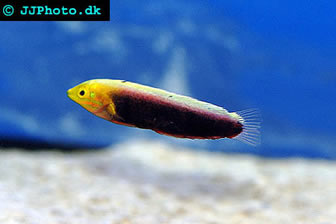Radient Wrasse
Halichoeres iridis
Common name: Orangehead Wrasse, Iridis Wrasse, Radiant Africa Wrasse
Scientific name: Halichoeres iridis
Max size: 5 in / 12.5 cm
pH: 8.1-8.4
Salinity: 1.020-1.025
Temperature: 72-78ºF (22-26°C)
The Radiant wrasse is just like most wrasse species a truly stunning species. They are however frequently a little sensitive in the beginning, which often can be attributed to specimens being in poor shape after transport. If you buy them in a local fish store you should insist on seeing them eat before you buy them. If you buy your Radiant wrasses online you should only by them from reputable dealers with a delivery guarantee. This species is relatively hardy once they have acclimatized to your aquarium. During the acclimatization process they spend a lot of time buried in the sand. This is perfectly normal and nothing to worry about.
Adult Radiant wrasses have a dark red body with softer color near the fins and near the edges of the body. The head is of a golden shade which gradually turns into yellow the closer to the dorsal fin you look. Females are less colorful than males.
The Radiant wrasse is not 100% reef safe as they eat small invertebrates such as feather dusters, shrimp, snails, tubeworms, and flatworms. Larger invertebrates and corals are safe. This species will eat fireworms and pyramidellid snails and thereby protect your corals and clams from these potentially very harmful species. The Radiant wrasse is relatively peaceful towards other species as well as other specimens of their own species. They can usually be kept in groups without any problems. They can be kept in a community aquarium with most other small peaceful fishes and recommended company includes leopard wrasses, flasher wrasses, firefish and small gobies. The Radiant wrasse not be kept with large or aggressive species.
The Radiant wrasse originates in the Indian Ocean off the coast of eastern Africa. Many of the specimens available in the trade have been collected in the waters of Kenya.
This species like to dig itself down into the bottom so don't be alarmed if you don't see it every time you check your fish. They sleep buried in the sand and will also head for the sand every time they feel spooked.
Radiant wrasse care and aquarium setup:
A single or a small group of Radiant wrasse can be kept in aquarium of at least 50 gallon / 200 L. They should never be kept in smaller aquariums as they are very active fish that like to swim a lot. The aquarium should have a deep layer of least 3 in / 7.5 cm fine grain sand on the bottom. This is important as wrasses like to dig themselves into the bottom substrate to hide. The aquarium should contain a lot of caves and overhangs. Corals and anemones can be used in the decoration. This species suitable for all types of tropical marine aquariums as long as you consider the fact that it, as earlier mentioned, is not 100% reef safe. They prefer a brightly lit aquarium with shaded caves. Keep the water quality high and stable.
They are excellent jumpers and it is important to cover the aquarium well.
Ideal conditions for Radiant wrasse is pH 8.1-8.4, salinity 1.020-1.025, and temperature 72-78ºF (22-26°C).
Feeding Radiant Wrasses
The Radiant wrasse is not too hard to feed and should be fed a varied diet including meaty food such as chopped up sea food and feeder shrimp. They usually accept marine flakes and pellets and those food types can be used as a base for their diet, but should be complemented with fresh, frozen or live meaty food. Give them vitamin enriched brine shrimp or other vitamin enriched food every now and then. Radiant wrasses sometimes act as cleaner fish and eat parasites of their tank mates. Make sure that they get enough food or your Radiant wrasse will gradually waste away in the aquarium. Feed 3-4 times a day.
Breeding Radiant Wrasse
We have no information about the successful breading of the Radiant wrasse in home aquariums. They do however spawn in large public aquariums. If you want to breed this species you likely need a large high aquarium that has enough room for them to perform their mating "dance". This species is a hermaphrodite. The dominant female turns into a male when there is a need for male. This means that you can by a group of juveniles and be sure that you will get fish of both genders eventually. A female can turn into a male in 10-14 days.
Wrasse Articles:
Bird Wrasse – Gomphosus varius
Dragon Wrasse - Novaculichthys taeniourus
Harliquin Tuskfish – Coerodon fasciatus
Hogfish - Information about Hogfish
Neon Wrasse – Halichoeres melanurus
Ornate Wrasse – Halichoeres ornatissimus
Queen Coris – Coris frerei
Radient Wrasse – Halichoeres iridis
Spanish Hogfish – Bodianus rufus
Striated Wrasse – Pseudocheilinus evanidus
Yellow Coris – Halichoeres chrysus
Line Wrasses:
Fourline Wrasse – Pseudocheilinus tetrataenia
Sixline Wrasse – Pseudocheilinus hexataenia
Eightline Wrasse – Pseudocheilinus octotaenia
Fairy Wrasses:
Exquisite Fairy Wrasse – Cirrhilabrus exquisitus
Lubbock's Fairy Wrasse – Cirrhilabrus lubbocki
Scott's Fairy Wrasse – Cirrhilabrus scottorum
Solar Fairy Wrasse – Cirrhilabrus solorensis
Flasher Wrasses:
Carpenter's Flasher Wrasse – Paracheilinus carpenteri
Dot-and-Dash Flasher Wrasse – Paracheilinus lineopunctatus
Filamented Flasher Wrasse – Paracheilinus filamentosus
McCosker's Flasher Wrasse – Paracheilinus mccoskeri

